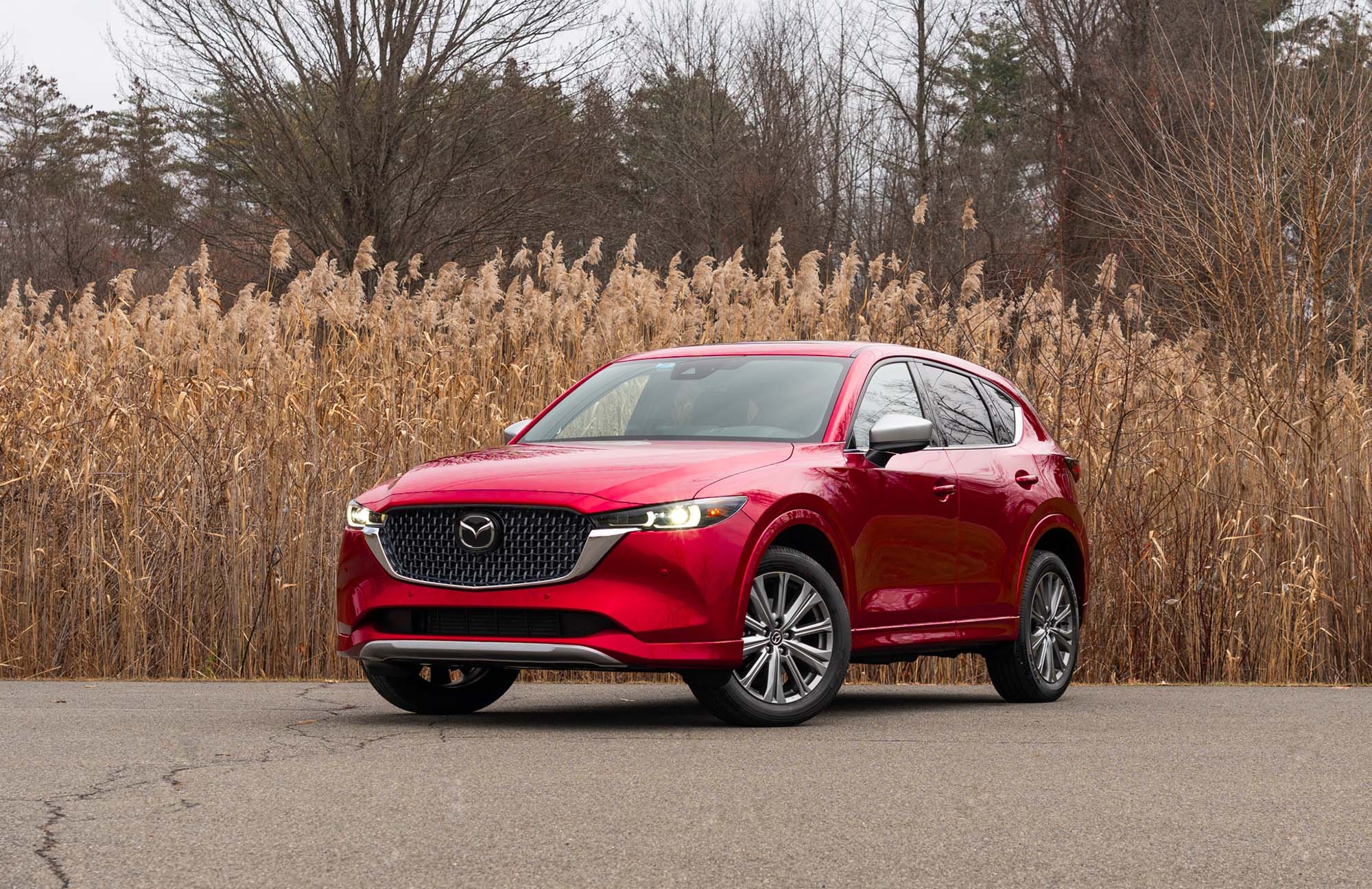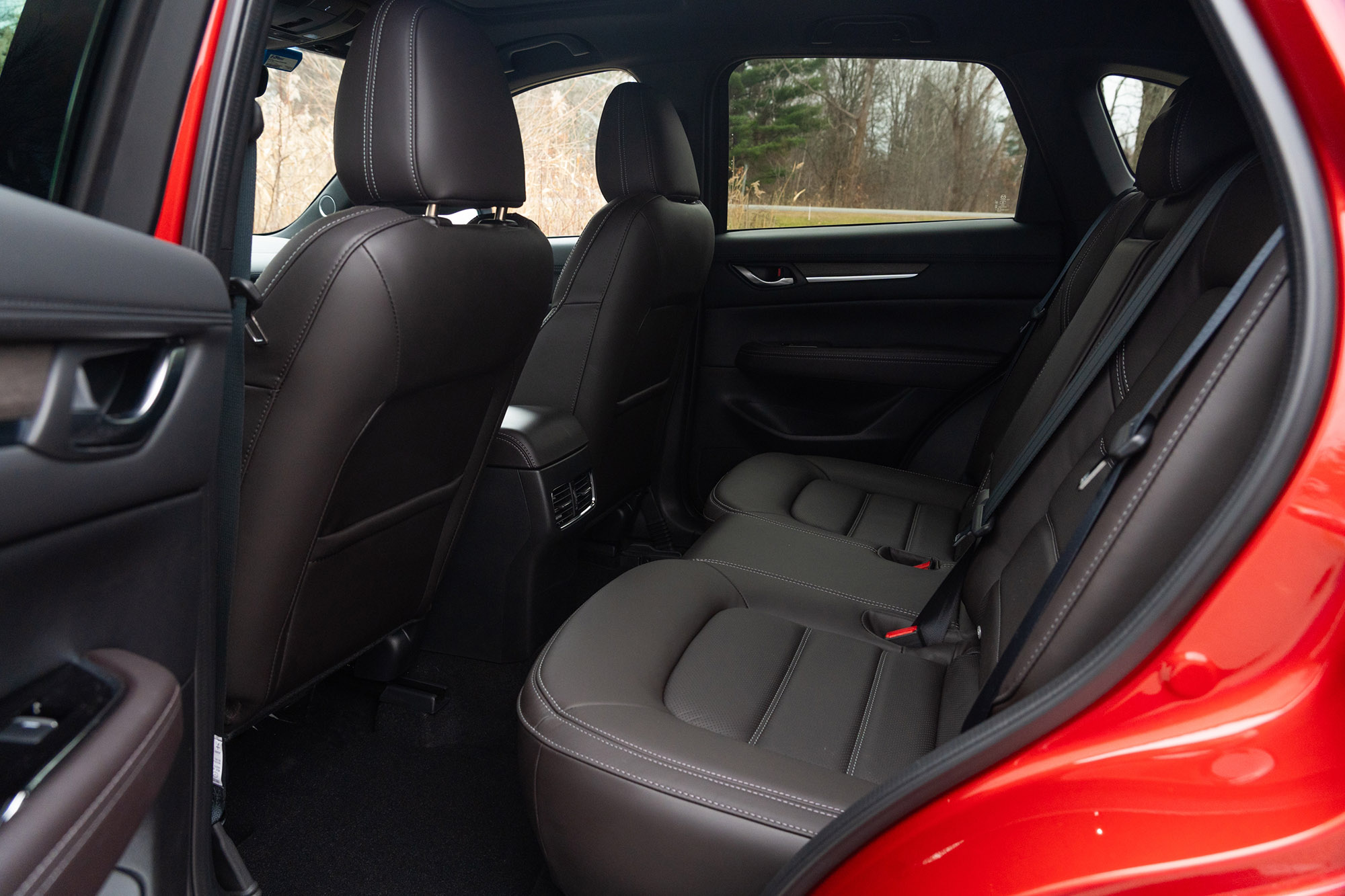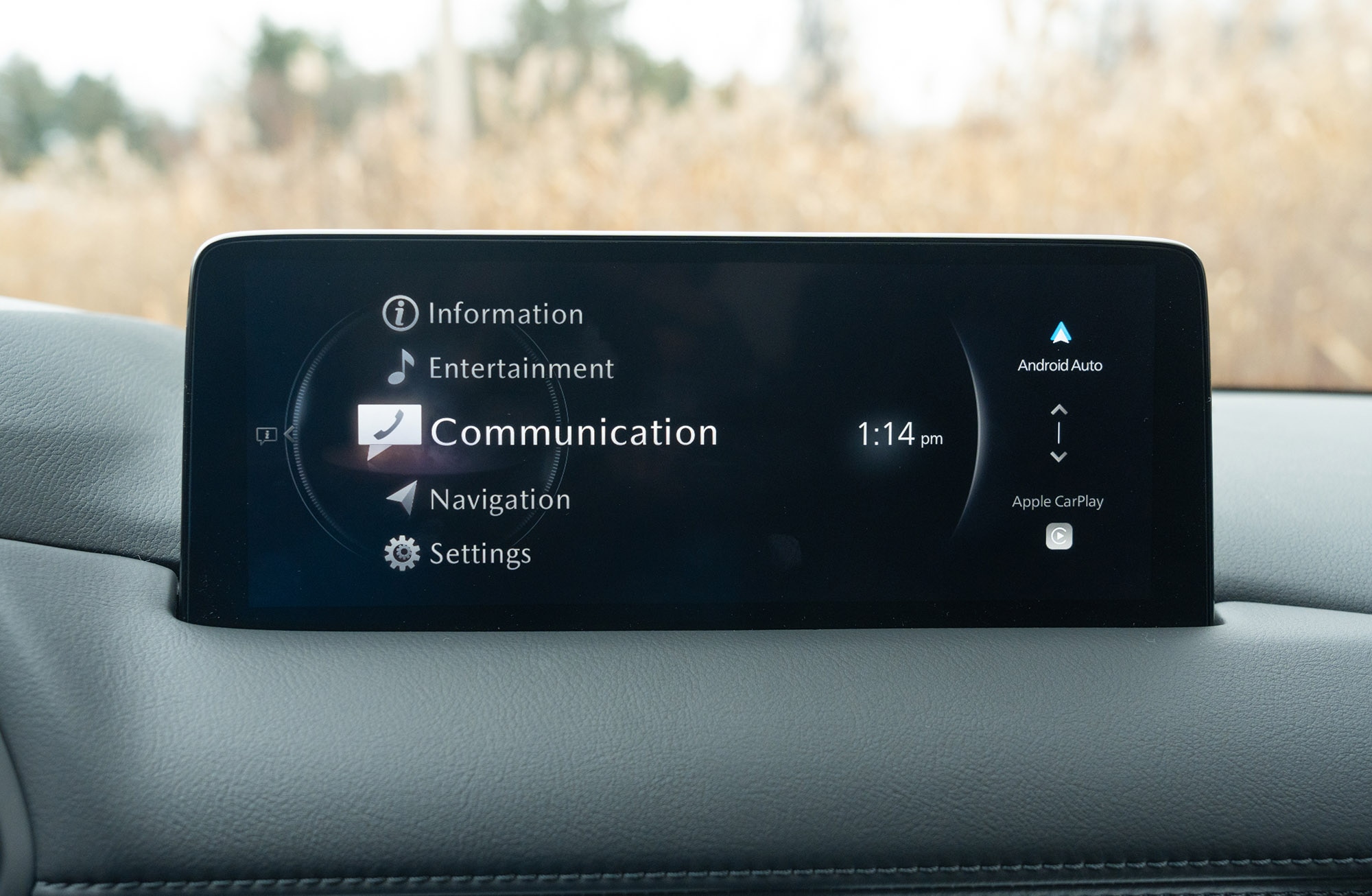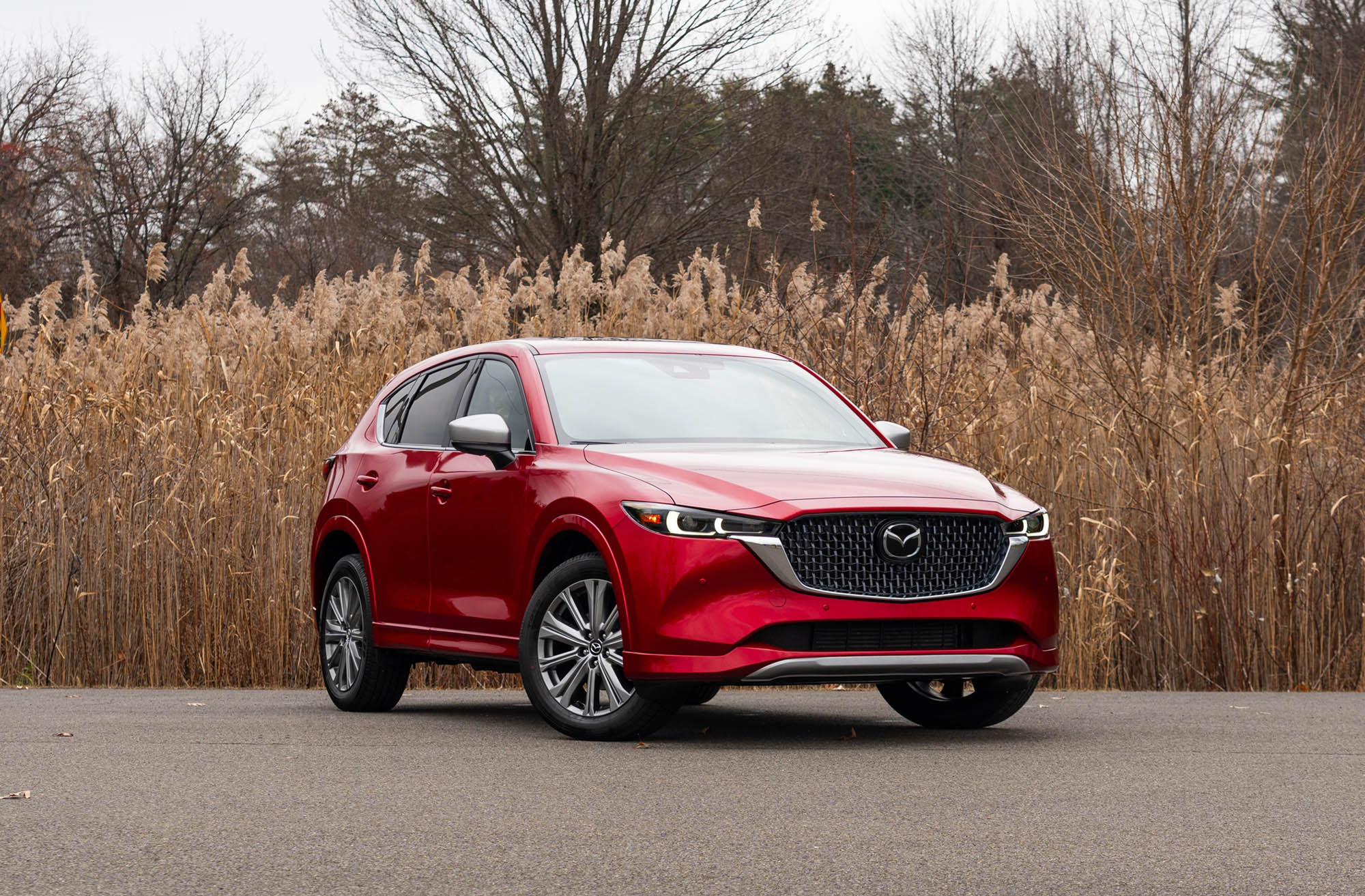2024 Mazda CX-5 Review and Test Drive
This crossover is aging but still engaging.
 Tim Stevens | Capital One
Tim Stevens | Capital One
It's an increasingly crowded space in the compact crossover SUV segment, and Mazda is doing its part to ensure that segment stays saturated, offering three crossovers on the smaller side: the CX-50, the CX-30, and the CX-5. (The automaker also sells the larger CX-90 and CX-90 hybrid crossovers.) The current-generation CX-5 was refreshed in 2022 but dates back to 2017. Given how quickly things are moving in the industry, it's no surprise that parts of this SUV feel a little dated. But, with that recent refresh and Mazda's dashing Soul Red paint color, the CX-5 still looks sharp, and it drives as well as ever.
 Tim Stevens
Tim Stevens
2024 Mazda CX-5 Offers a Trim Level for Everyone
The 2024 CX-5 is available in two model series, each equipped with a four-cylinder engine and standard all-wheel drive. The CX-5 2.5 S has a peppy 2.5-liter four-cylinder engine making 187 horsepower, while the CX-5 2.5 Turbo uses a turbocharged engine making up to 256 horsepower on premium gas.
In addition, eight trim levels are available. The first five apply to the 2.5 S and include the Select, Preferred, Carbon Edition, Premium, and Premium Plus. The top three are turbocharged: Carbon Turbo, Turbo Premium, and Turbo Signature. Starting prices range from a little less than $30,000 to more than $40,000.
For this review, I tested a 2024 Mazda CX-5 2.5 Turbo Signature model in upstate New York. The only option was the Soul Red Crystal Metallic paint, bringing the manufacturer's suggested retail price to $42,705, including the $1,375 destination charge to ship the SUV from its assembly point in Hiroshima, Japan, to a U.S. dealership. Mazda provided this SUV for a one-week loan.
 Tim Stevens
Tim Stevens
Sharp and Eye-Catching, Especially in Red
Though the CX-5's shape is decidedly familiar at this point, the recent updates to the detailing help give it a modern vibe. It's especially fresh in Soul Red Crystal Metallic, which I think is worth the price premium.
Once inside, though, things look more pedestrian. Dark colors abound, and the dark gray faux wood-grain inserts on the dashboard and door panels don't add much contrast to the scene. Door vents and a few other trim bits are bordered in shiny chrome, but there's little to captivate the eye here.
Thankfully, the materials are generally good. The leather and vinyl surfaces match well with the soft-touch plastics on the upper reaches of the dash. Plastics on the lower portions of the door panels and the center console are harsher but are mostly out of reach.
A traditional, upright shift lever sits surrounded in piano-black plastic that will forever be a magnet for dust and fingerprints. Still, this shifter feels refreshingly familiar, especially given the more outlandish means of gear selection I've seen from other manufacturers.
Behind that sits Mazda's five-way rotary controller for the infotainment system, perfectly positioned for easy spinning while your arm sits on the armrest. Shortcut buttons for the main menu pages surround it, while a pert little volume knob sits just to the side.
The climate controls are low on the dash, with physical buttons and knobs for all the essential features. Projecting high from the dashboard is the 10.3-inch infotainment display.
You'll find the bulk of the remainder of the SUV's controls on the steering wheel. Your left thumb can adjust volume, skip tracks, toggle phone calls, or trigger the voice-recognition system. The right thumb handles cruise control duties and toggles the lane-keeping assist.
 Tim Stevens
Tim Stevens
Comfortable Seating for Five and Plenty of Headroom
The CX-5's seating position is on the tall side, which makes getting into the second row easier. From there, you have excellent visibility in all directions, which should minimize nausea for those prone to motion sickness.
In addition, generous headroom will likely minimize complaints for those with extended torsos. Legroom is more limited but still generous enough for most passengers.
Seating three adults across in the back for five total passengers is possible for short trips. However, the reasonable limit for lengthier trips is two in front and two in back. That's doubly true because the CX-5 hides its few rear-seat creature comforts inside the fold-down armrest. You'll find the two USB-A charging ports and the buttons to activate the rear seat heaters there.
Two more USB ports live in the armrest between the front seats (USB-C). Another is situated just below the climate controls. There's a wireless charger down there, too, angled so that my phone constantly fell forward and lost connection, making it borderline useless.
The seats are heated up front, and quite effectively so. The steering wheel heating in my test car, however, was disappointing. It was on the tepid side, and only the 9 o'clock and 3 o'clock positions got warm. The upper and lower portions of the wheel stayed cold.
Both front seats are power adjustable, and the driver's seat adds lumbar adjustments and memory settings.
 Tim Stevens
Tim Stevens
Modest Cargo Space but Easy Loading
The power liftgate on the Mazda CX-5 opens high, giving easy access to 30 cubic-feet of cargo space. That figure lands on the smaller side for this segment, just ahead of the 28.9 cu-ft offered by the Subaru Forester but short of the 37.6 cu-ft from the Toyota RAV4.
That said, the CX-5's space is entirely usable. The floor in the cargo area is flat and wide, and while you won't find any trick cubbies beneath it, you will at least find a space-saving spare tire down there.
Levers on either side flip the seats down, split 40/20/40, leaving you free to drop just the middle portion if you want to run some lumber, skis, or perhaps a generously sized baguette through while still seating two passengers on either side. Fold all three sections down and the cargo area jumps to 58.1 cu-ft.
In the main cabin, pockets in all four doors are big enough for water bottles, augmenting the two front and two rear cupholders. The cubby in the front armrest has enough room for a small box of tissues, though the glovebox won't hold much more than the owner's manual.
 Tim Stevens
Tim Stevens
Mazda Connect Offers Only Some Touch Sensing
The Mazda Connect infotainment system employs a 10.3-inch display nestled into the top of the dashboard. It's a somewhat awkward reach from the driver's seat, but that's partly by design because, with few exceptions, it isn't touch-sensitive. Instead, most interactions require using the five-way rotary controller on the center console, the five buttons surrounding it, and your voice.
But you probably won't use your voice much. Voice recognition in the CX-5 is of the old-school, limited variety, requiring that you explicitly say "address search" before speaking a destination, for example. You can tune the radio by voice or search for points of interest by category, but more nuanced commands such as "I'm hungry" or "find me the closest Starbucks" result in preprogrammed apologies.
The navigation experience is basic but functional, quickly routing and presenting directions in a clear, easy-to-follow way on both the infotainment screen and the head-up display. Still, the integrated navigation in Android Auto or Apple CarPlay is far superior.
Once connected to either of those systems from your phone, the 10.3-inch Mazda Connect display responds to touch inputs. That also means, however, that the slightly awkward reach becomes a problem. You can still use the rotary controller if you prefer, but it can feel like such an arduous way to interact with the touch-optimized interfaces developed by Apple and Alphabet that you may find yourself having to lean forward.
When using either service for navigation, the CX-5 kindly pulls prompts into the head-up display, including street names.
A 10-speaker Bose audio system (available in higher trim levels) handles speaker duties, including a subwoofer situated near the rear spare tire. The system offers well-rounded sound — nothing too overpowering yet quite good for something at this price point.
 Tim Stevens
Tim Stevens
Some Safety Features Work Better Than Others
The 2024 Mazda CX-5 2.5 Turbo Signature comes with active safety systems including forward-collision warning, automatic front and rear braking, blind-spot monitoring, lane-departure warning, lane-keeping assist, lane-centering assist, and adaptive cruise control.
Those features are easy enough to configure through the infotainment screen. There's a dedicated button for the lane-departure warning system on the left side of the dashboard, next to a dedicated button to bring up the surround-view camera. On the steering wheel, a separate button turns on or off the active lane-keeping systems.
The adaptive cruise control quickly and reliably detected traffic ahead and appropriately adjusted the CX-5's speed during my test drive. Likewise, the lane-departure warning system did well at notifying me whenever the SUV wandered out of the lane. However, the active lane-assist features disappointed me.
The CX-5 struggled to track even well-painted road markings. This made the active steering control unreliable at best. It was most dependable on the highway but often lost track of things even there, particularly in challenging lighting situations.
 Tim Stevens
Tim Stevens
2024 Mazda CX-5 Is Available With or Without Turbocharging
The more affordable versions of the 2024 CX-5 come with Mazda's Skyactiv-G 2.5-liter four-cylinder engine, which makes 187 horsepower and 185 pound-feet of torque. The three higher-end trims step up to the Skyactiv-G 2.5 Dynamic Pressure Turbo engine, generating 256 horsepower and 320 lb-ft of torque if you're running 93-octane fuel. Go with a lower-octane fuel, and those numbers drop to 227 horsepower and 310 lb-ft.
All that power flows through a six-speed automatic transmission with paddle shifters and then to an all-wheel-drive system. The CX-5 also includes Mazda's G-Vectoring Control Plus system. This technology relies on the SUV's center differential to apply more or less torque front to rear to make the vehicle more nimble through the turns.
 Tim Stevens
Tim Stevens
Sprightly but Just Short of Sporty
Though somewhat unremarkable from a design standpoint, Mazda's crossover SUV has a driving character all its own. The automaker has a sports-car heritage, and while there's not much in common between the brand's lively MX-5 convertible and the CX-5, I still noted Mazda's efforts to make this SUV as engaging as possible.
The steering feel is on the firm side but with reasonably good feedback. Though turbocharging doesn't exactly turn this thing into a rocket ship, it is sprightly enough in Sport mode. Between the forced induction and the relaxed automatic transmission, there's a bit of lag between stepping on the gas pedal and acceleration. Still, the CX-5 is reasonably engaging, turning eagerly into corners and gripping well through them.
 Tim Stevens
Tim Stevens
Sport is one of three driving modes that also include Normal and Off-Road. No matter which one you choose, all that's changing is the throttle map and the automatic transmission's willingness to hold gears. Even in off-road mode, you won't be hitting the trails, but if you have a challenging driveway, it might provide the extra torque to help get to the top on a snowy or muddy day.
The CX-5 is far happier on the school run or heading to the grocery store, where its easy loading shines. Handling is a bit on the firm side for a crossover SUV, but not to the point where it's punishing, the 19-inch wheels and tires of my test vehicle doing a great job of soaking up all the road's imperfections.
On the highway, the CX-5 is calm and quiet, presenting an excellent opportunity for enjoying a Bose sound system.
According to the EPA, the 2024 Mazda CX-5 2.5 Turbo Signature gets 22/27/24 mpg city/highway/combined. In my testing, I saw slightly better, getting 24.9 mpg on a loop with a mixture of highway and rural driving.
 Tim Stevens
Tim Stevens
A Solid SUV That's Showing Its Age
The 2024 Mazda CX-5 is competent in virtually every way and is sharp looking and rewarding to drive. Its interior technology does feel dated, however, and while the inclusion of Android Auto and Apple CarPlay connectivity helps, a more capable collection of advanced driving-assistance systems would help this Mazda stand out more in an intensely competitive segment.
Written by humans.
Edited by humans.
 Tim Stevens
Tim StevensTim Stevens is a veteran editor, analyst, and expert in the tech and automotive industries. He helmed a major website's automotive coverage for nine years and acted as its content chief. Prior to that, Tim served as the editorial lead at a tech-oriented site and even led a previous life as an enterprise software architect.
Related articles
View more related articles